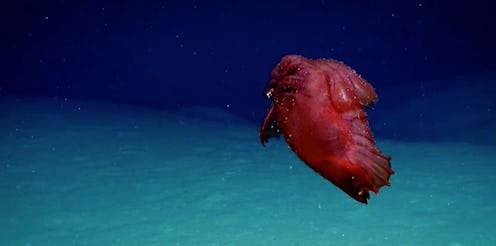News
You Need To Watch This Video Of A "Headless Chicken Monster" In The Gulf Of Mexico

Researchers with the National Oceanic and Atmospheric Administration uncovered a strange sea cucumber with an even stranger name on a recent deep sea dive. The agency posted video footage of the encounter on Thursday, and you should probably watch this NOAA video of the "headless chicken monster." The clip is delightful, bizarre, and strangely calming.
Researchers spotted the creature, officially called the Enypniastes eximia, during the NOAA Ship Okeanos' 2017 dive in the Gulf of Mexico. Footage shows the creature feeding off of the ocean floor, and the manner in which it does so — unraveling its tentacle-feet onto the sand and soaking up the nutrients therein — is incredibly odd and absolutely mesmerizing to watch.
‘These tentacles, which are modified tube feet, scoop in the sediment, and they are only taking in materials from the surface of the sediment, which is higher in organic material," one of the NOAA researchers says in the video.
As another researcher points out in the video, it's not entirely clear why the creature has been nicknamed the "headless chicken monster, because it spends most of its time looking more like a gelatinous blob than a chicken (or any kind of land animal, for that matter).
"I just think it makes no sense," the researchers says at the end of the video. "What part of that looks like a headless chicken?"
That said, there is one brief moment in the video, around the 48 second mark, when the cucumber swims upward and assumes a shape that one might compare to that of a chicken without a head, if one were so inclined. Enypniastes eximia has also been nicknamed "the dreamer" and "the Spanish dancer," presumably due to the unpredictable but graceful manner in which it swims through the sea.
The NOAA's Okeanos Explorer is a federally-funded ship that was commissioned in 2008 in order to "explore our largely unknown ocean for the purpose of discovery and the advancement of knowledge," as the NOAA explains on its website. The goal of the project is not to answer any specific question, but simply to explore parts of the ocean that humans haven't yet been to.
"The ocean is 95 percent unexplored, unknown, and unseen by human eyes," the NOAA writes on its website. "Resource managers cannot manage what they do not know. To understand, manage, and protect the ocean and its resources, NOAA believes it is critical to support a systematic program of ocean exploration, using the best of ocean technology to explore, discover, inform, educate, and motivate."
The headless chicken monster wasn't the only oddity the Okeanos Explorer stumbled upon during its 2017 Gulf of Mexico expedition. The vessel's researchers also spotted — and, more to the point, posted video footage of — various other strange sea creatures, including the shortfin squid and the cartoon chimera, a charming critter that's often referred to as the "spook fish" for its unusually large eyes.
The crew also filmed a fish called the armored searobin, a strange-looking creature that attempted — adorably — to "scare off" the researchers by puffing up its fins and mouth when they approached it.
"It just reminds me of this weird mash-up that looks like you took so many different animals and put it together," one of the researchers said of the searobin. "It has fins that can walk, these huge projections coming off of its face, the colors. It just...nature is amazing."
If you'd like to watch the rest of the NOAA's videos and photos from the Gulf of Mexico expedition — and you should, because they're marvelous — you can do so here.